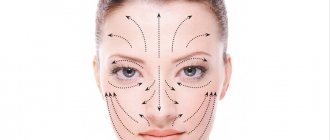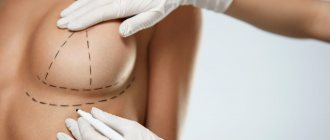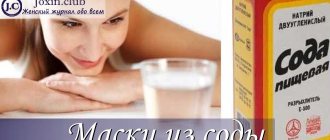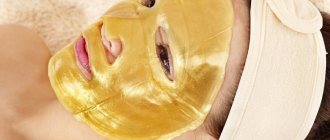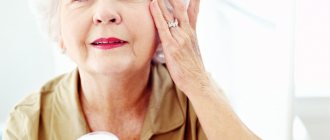A sheet mask is a relatively new stage in skin care that came to us from Japan. It was local beauty gurus who were the first to think of using pieces of fabric with slits for eyes and lips, soaked in gel or serum. By fitting tightly to the face, the mask does not allow nutrients to evaporate and ensures maximum effectiveness of the components.
Thirty years ago, in elite Japanese beauty salons, fabric masks were a whole ritual: quiet music, aromatherapy, healing composition... And today we can easily apply them to our faces and continue going about our business!
Properties of fabric masks
Let's be honest: fabric masks are the beauty heroes we've been waiting for for so long. What superpowers do they have?
- Moisturizes facial skin, fights dryness and dehydration.
- They rejuvenate and have a lifting effect.
- Evens out facial tone and eliminates dullness.
- Tones and gives the skin a natural glow.
- Intensely nourishing.
- Eliminate inflammation and redness, soothe the skin.
- Cleanses pores and mattifies.
- Restores the fat balance of the skin.
It is also important that the effect of fabric masks is visible after the first use. Therefore, they can be used as an SOS tool before an important event or date!
By the way, the best fabric face masks perform several functions at once, or even all at once.
Features of the composition
The exact effect the mask will have depends on the composition of the impregnation:
- For moisturizing - hyaluronic acid, glycerin, snail mucin, lipohydroxy acids, pomegranate extract.
- To combat redness - aloe, chamomile extract, lavender oil.
- For radiant skin - caffeine, vitamin C, centella asiatica, natural pearl extract, sakura extract.
- For wrinkles – retinol, vitamin E, peptides, collagen, algae extract, colloidal gold, EGF (epidermal growth factor), antioxidants.
- Anti-inflammatory, sebum-regulating – zinc, ginseng extract, black tea extract.
- For nutrition - natural oils.
- To tighten pores and mattify (in fabric masks for problem and oily skin) – activated charcoal, clay.
Woven base material
It’s no coincidence that fabric beauty masks are called “sheet masks” (thanks, Cap!). They differ not only in the composition of the impregnation, but also in the material from which the base is made:
- Cotton is a natural fabric with good absorbency.
- Hydrogel is a non-woven material impregnated with a gel whose consistency resembles jelly. Upon contact with warm skin, the gel begins to melt, releasing the active components of the mask.
- Microfiber – fits tightly to the face, like a second skin. Pleasant to the touch, practically does not tear.
- Biocellulose is a thin fabric that can absorb a large amount of useful substances.
- Natural cellulose is a fairly dense fabric: it sticks well to the face and does not slip off.
Benefits of using sheet masks
Perhaps one of the main advantages of a fabric mask is its ease of use. Just spread the foundation along the contours of your face, giggle at your reflection in the mirror and... that's it! What other “buns” of masks will please you?
- Does not require rinsing.
- They have an immediate noticeable effect.
- Contains useful substances in concentrated form.
- They solve almost any skin care problem.
- Maximum hygienic.
What does the last point mean? It's simple: using masks in jars, we can accidentally introduce bacteria into the composition: for example, on our fingers or by accidentally leaving the jar open. In the stuffy atmosphere of the bathroom (which is where, contrary to the advice of beauty experts, we most often store skincare products), these bacteria can multiply and cause inflammation.
In the case of fabric masks, this problem does not occur to you. In a sealed package there is exactly as much product as is needed for one procedure.
PS Do not store facial cosmetics in the bathroom!
Which one will we take?
Fabric masks are so multifunctional that it is hardly possible to do without them in everyday care. Thanks to their ergonomic and comfortable shape, as well as the active serum, they can be used both regularly and urgently: literally before the event itself. What can these wonderful beauty products even do?
- Moisturize and nourish
- Soothe and tone
- Return balance to the skin
- Gives shine and even tone
- Cleanses the skin, tightens pores, has a lifting effect
The mask itself can be made of cotton, microfiber, biocellulose, or hydrogel. There is no big difference between them; it is much more interesting to find out what useful things can be in the composition with which the fabric is moistened. Let's list the most popular components of fabric masks.
- Hyaluronic acid and glycerin are without a doubt number 1 and number 2 in any cosmetic product that aims to deeply moisturize the skin.
- Snail mucin is a very popular component of cosmetic products. It is a secretion (mucus) secreted by a snail. It has the amazing property of restoring skin cells, relieving inflammation, enhancing the production of its own collagen.
- Pomegranate extract is an active anti-aging component. Contains amino acids, organic acids (malic, tartaric, citric and others), trace elements and vitamins. Has a whitening effect and helps fight pigmentation. Protects from ultraviolet radiation and restores skin after sunburn.
- Aloe - there is hardly a single person who has not heard about the benefits of aloe vera. Rejuvenation, restoration, hydration - this is only part of what this component is strong at. Helps with inflammation and peeling. Actively fights seborrhea and acne.
- Caffeine is one of the important components of SOS masks. Caffeine promotes metabolic processes in cells, which stimulates skin regeneration. Fights swelling, giving the skin a youthful and toned appearance, and does it quickly.
- Vitamin C is a strong antioxidant and has the same restorative SOS effect, which allows you to give your skin a fresh look.
- Vitamin E and retinol actively fight wrinkles.
- Chamomile, ginseng, and green tea extracts are excellent anti-inflammatory, soothing irritated, redness-prone skin.
Don't forget about various natural oils for nourishment and clay for tightening pores and smoothing the skin. Hardly any other beauty product can offer such a variety of functionality and at the same time such a convenient form. In a word, a fabric mask is a truly irreplaceable thing in any girl’s cosmetic bag.
pexels.com/
Fabric cosmetic masks: application features
To simplify your acquaintance with fabric masks, we have compiled a small beauty dossier on them and formatted it in a “Question-Answer” format:
How long to keep the mask on? Can it be longer?
As a rule, the mask is kept for 15 to 30 minutes (this information is always on the package). You can take longer, but... why? During the time specified by the manufacturer, the skin will have time to absorb the maximum possible amount of nutrients. It simply won’t fit anymore. By the way, this also applies to ordinary masks with a cream texture.
And one more thing: you shouldn’t leave a fabric mask on overnight. During this time, it can dry out and stick either to your face or to the pillow.
Can the mask be reused?
No, you cannot reuse the mask. You don't use the same cotton pad twice, right? It's the same here. If there is a lot of excess gel left inside the package, apply it to your neck, décolleté or arms.
When to apply the mask: morning, afternoon or evening?
A sheet mask is a universal remedy that can be used at any time of the day. The only difference is that in the morning you will need to remove the remaining mask with a cotton pad. After 15-20 minutes you can start applying makeup.
How often should you use the mask?
Some masks must be used in courses: this way the effect will be maximum. In all other cases, it is better to focus on the needs of the skin. Feeling dry? Use a moisturizing mask. Does your skin need mattification? An activated carbon mask will help you.
What precautions are there?
- It is no coincidence that fabric masks have slits for the eyes: the impregnating composition is not intended to care for sensitive skin around the eyes, so you should not smear it on this area.
- It is better to store a fabric mask in the refrigerator or cool place. Despite the sealed packaging, the impregnating composition may deteriorate if exposed to high temperatures and direct sunlight.
- Cloth masks often contain exotic ingredients that can cause an allergic reaction. Test them before use.
- Fabric masks are not recommended for use on severely irritated skin (for example, during an exacerbation of acne).
What sheet masks are the most effective?
They are all effective! But you can further increase the efficiency of any mask in simple ways:
- 10 minutes after the start of the procedure, turn the mask over to the other side.
- Turn applying a mask into a beauty ritual: turn on pleasant music, take a horizontal position and calm down. This will help relax the facial muscles and enhance the effect of the mask.
How to care for sensitive skin around the eyes?
Along with a fabric face mask, use patches or special masks for the skin around the eyes. By the way, these are in the Garnier line!
Folliculitis
Folliculitis (Figure 6) on the face is more common in men and is associated with facial hair. Occlusive folliculitis, bacterial folliculitis, and pseudofolliculitis barbae (caused by ingrown hairs and poor shaving of the face and neck) have clinically similar presentations with papules, pustules, and, less commonly, nodules. A smear can rule out a bacterial infection. Gentle daily cleansing with a soap-free cleanser, gentle exfoliation (to remove ingrown hairs), and replacing dry shaving with wet shaving using special products can all help combat the condition. Antibiotic treatment is indicated where the presence of bacteria is detected; in purely inflammatory (sterile) cases, a combination steroid/antimicrobial cream can be used.
Figure 6. Folliculitis
- Cleanse your skin with a mild, soap-free cleanser.
- Apply a light emollient at least 30 minutes before putting on facial protection.
- Use special protective dermatological patches, sticking them on the skin of the bridge of the nose and cheeks.
- Wipe the skin under the PPE with a silicone-based protective cloth to form a film that protects the skin from the harmful microenvironment.
- Take the time to adjust the mask to your face and make sure it is not too tight.
- Take regular breaks from using the mask (every hour for respirators) to relieve pressure and prevent moisture buildup.
- Drink enough water.
- Maintain good oral hygiene (brushing teeth twice daily and flossing/brushing daily).
Consider seeing a dermatologist if the condition is severe or if the condition does not respond to the treatments described above. Also consult a specialist if special tests are indicated for you, such as skin testing and patch testing if you suspect a contact allergy.
- Consider how facial dermatosis affects the patient's quality of life, work, and relationships with others.
- Consider the different Fitzpatrick skin types when making treatment decisions, given the higher risk of post-inflammatory dyspigmentation and/or scarring in darker skin types.
- Consider the professional implications of diagnosis and treatment for the patient and discuss these as part of the consultation.
How to use a sheet mask: step-by-step instructions
Let's move from theory to practice. This beauty tutorial will be very short: just three steps to beautiful and glowing skin!
STEP 1: CLEANSE YOUR FACE
The fabric mask is applied only to clean skin. The preparation ritual includes makeup removal, cleansing gel and toner. The latter will help remove remnants of cosmetics from the face and become a conductor between the beneficial components of the mask and the skin.
STEP 2: APPLY MASK
The package with the mask should be opened immediately before use. The mask itself needs to be carefully unfolded and spread on the skin of the face. No creases or air bubbles! Special side slits will help you completely match the shape of your face.
STEP 3: COMPLETE THE RITUAL
After 15 minutes (or other time indicated on the package), remove the mask and distribute the remaining product over the skin with soft patting movements. This massage will increase blood circulation and help the skin better absorb the healing composition.
The principle of virus spread
It is generally accepted that particles of infected saliva and mucus fly a couple of meters away from a sick person. Allegedly, coronaviruses are so heavy that they are not able to fly a greater distance. In convincing us of this, WHO relies on the properties of previously studied coronaviruses.
A sick person poisons the air with microscopic droplets with volumes of 7–200 microns. Details:
- During a minute-long conversation, about 210 virions with sizes up to 100 microns enter the air.
- With a cough - from 10 to 50 thousand viral particles, of which only 20% have a size of 100 microns, the rest are smaller.
- With a sneeze - from 100 to 800 thousand, of which only half have a size of 100 microns, and 30% of “sneeze” microbes are from 1 to 25 microns.
After coughing, large particles of infection fly no more than 1 meter. They are the ones that settle on clothing, hair and surfaces.
Moreover, large particles first enter the nasopharynx and a person has time to “prevent” the infection from further. Small ones immediately enter the lungs and lead to the development of fatal pneumonia.
This is why WHO strongly recommends wearing masks and maintaining a distance of at least 2 meters.
Rating of the best sheet masks Garnier
Imagine, each Garnier sheet mask contains half a bottle of hydrating serum! How, then, to choose between one good product and another, which is no worse? To help you figure it out, we compiled our own rating of the best fabric face masks from Garnier and included in our top masks both for different skin types and for solving specific problems.
Clinical researches
The first study compared the effectiveness of plain masks and N95 respirators. Almost three thousand medical workers were divided into two groups: the first half used regular masks, the second half wore respirators. In the first group, 207 people were ill with the seasonal influenza virus, in the second - 193. The difference between 7.2% and 8.2% is less than a statistical error.
Similar results were obtained by Canadian researchers. In a group of 446 nurses, 50 who wore masks and 49 who used respirators had the flu. The incidence was 23.6% and 22.9%, respectively—that is, the difference was again outside the margin of error.
These studies showed that replacing masks with respirators did not have a significant effect - masks and respirators were compared with each other, and not with the absence of protection in principle. To judge the effectiveness of virus protection, it would be necessary to recruit a control group that would not use protection at all.
Of course, conducting such a study in a hospital setting is extremely dangerous - nurses without masks and respirators would be vulnerable to other diseases and infections. Therefore, scientists from Australia transferred the experiment from clinics to home conditions.
Researchers observed 143 families in which children became ill with respiratory viral diseases. A third of families received medical masks, a third received disposable surgical respirators, and the rest did not use protection at all. In a group of 94 adults wearing surgical masks, the incidence was 5%. Of the 92% with N95 respirators, only 4% got sick. In the control group, the infection rate reached 17%.
The four-fold difference is impressive, but researchers say there could be even fewer cases. Adults often neglected the rules for using masks and respirators - they wore them longer than required, touched their eyes and lips with dirty hands, and disposed of masks incorrectly.
In February 2022, the European Center for Disease Control and Prevention issued recommendations for healthcare workers working with patients during the coronavirus pandemic. Recommendations require the use of FFP-2 and FFP-3 respirators. In addition to a respirator, you must use safety glasses or a transparent shield, gloves and a moisture-resistant long-sleeved robe.
N95 respirators
Respirators are sealed, tight-fitting masks that pass all air through a filter designed to block 95% or more of particles measuring 0.3 microns. They must be tested for leaks before they can be considered safe and are traditionally considered disposable. However, outbreaks of airborne diseases such as coronavirus have led to regional shortages of these masks. This has led many researchers to explore possible disinfection procedures that may allow reuse. Unfortunately, many common decontamination methods such as steam sterilization, bleach washing, and EtO sterilization have been shown to reduce filtration properties.
On the other hand, disinfection using microwave-generated steam, warm moist heat, and UVGI has been found to be effective in inactivating the H1N1 influenza virus and causes the least degradation of mask integrity.
Microwave steam
Plastic containers with perforated lids, as shown, are filled with approximately 50 ml of tap water at room temperature. The contaminated N95 mask is placed in the center of the assembly and loaded into the microwave oven, exposed to radiation for two minutes (one minute per side). Using this method resulted in an average reduction of 5.06 viable viruses.
Hot water
An airtight container is filled with approximately one liter of water. A plastic support post is placed in the container on which the mask is placed. It should be heated to 65℃ for 3 hours in the oven, or on the stove. The mask is then placed on the support rack and returned to the oven for another 30 minutes. Using this method resulted in an average reduction in the number of viable viruses of 4.81.
Lamp, ultraviolet radiation
A UV-C lamp (80 W, 254 nm) is used to expose contaminated FFRs to UV radiation. For 15 minutes, treat the mask on each side (external and internal). Using this method resulted in an average reduction in the number of viable viruses by 4.81. Although tests have shown that UVGI exposure does not reduce aerosol penetration above 5%. A statistically significant increase in penetration does occur, meaning that repeated use of this disinfection method will degrade the properties over time.
The easiest but longest way
When reusing N95 masks, leave the used respirator in a dry place in the air for 3-4 days to dry it. The polypropylene in N95 masks is hydrophobic and contains no moisture. COVID-19 needs a host to survive - it can survive on a metal surface for up to 48 hours, on plastic for 72 hours and on cardboard for one day. When the respirator dries out after 3-4 days, the virus will die.
- Take four N95 masks and number them (#1-4).
- On the first day, use one No. 1, then let it dry for 3-4 days.
- On the second day, use No. 2, then let it dry for 3-4 days.
- Same for day 3 and day 4...

